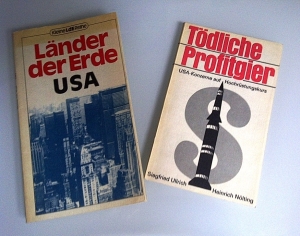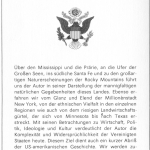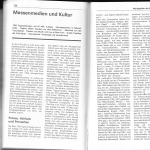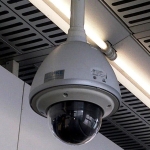Tearing Down the Walls that Divide – 25 Years after the Fall of the Berlin Wall – Lessons in Light of the Recent US Election Results
Whether or not the politics can assert a line, which can use the large economic, scientific, technical and spiritual potential of the USA in a peaceful cooperation with the international community to bring about a solution for the global problems of mankind — above all maintaining peace — will therefore be decisive in determining the perspectives of the US society. – Last sentence of Walter Stock’s Länder der Erde: USA (Countries of the Earth: USA), DDR 1987
For the first time in the brief but colorful history of Letts Hall dormitory, a phone rang in the distance and no one raced to respond. Not even the climax of our young lives – David Letterman’s reading of the “Top 10 Reasons Why” list – could rival this. Nothing ever had. History may be a recounting of past events but we knew this time we were living it – now – November 9, 1989, – the fall of the Berlin wall.
When operation “Wall of China” commenced on August 13, 1961, the East German government justified the 3.6-meter high, 155 km long mass of barbed wire fence and concrete as an “antifascist wall of protection.” For millions of German citizens, however, the wall represented an impenetrable obstruction dividing loved ones, for the rest of the world, the ultimate symbol of the Cold War dividing East from West. In contrast, the 7.5 meter high, 5000 km long Great Wall of China was a fortification protecting the Chinese from invading Mongol and Turkic tribes. For some, walls keep people out; for others walls keep people in.
My first real recognition of the walls came at age 16 when visiting East Berlin for a day. Surrendering my passport to the East German border guard, the voice of my seventh grade history teacher, resounded in my mind. “Just eight minutes from total destruction and annihilation!” he thundered fist clenching, voice rising as he paced the aisles between our desks. Silent a significant second or two he then would sneak up behind Kristin F, one of the quietest girls in our class, and explode, “Boom!” nearly jolting her and the rest of us to tears. Mr. M. dramatically confirmed what we were all knew to be a fact of lives.
We were the Cold War generation.
Our trivia repertoire included the random knowledge that if through some twist of fate we managed to be the sole survivor of a nuclear holocaust, we’d be sharing the world with cockroaches while subsisting off of Hostess Twinkie cakes. Our lives progressed teetering on the brink nuclear annihilation and overshadowed by the imminent threat of communism.
“Don’t look so scared. I don’t bite,” the young DDR soldier grinned stamping my passport. “But we’re enemies,” I thought. Throughout the day I was confronted with more of my enemies – carefree school children teasing one another, young mothers buzzing in chatter, frail
Omas warming benches. The buildings were grey and depressing but the people were friendly and often times tried to exchange their DDR Marks for our Western blue jeans.
But we needed our pants and already had too many DDR marks to begin with. Everyone entering the DDR was required to exchange 25 DDR marks a day, which, given the very low cost of food and general lack of any consumer products, proved a difficult undertaking. And one that wasn’t optional either because transporting those DDR marks back out of the country was illegal.
With our bellies full and no interest in the DDR version of blue jeans, we wondered if it would be strictly verboten to just give the money away and somehow suspected it might. Thankfully, that’s when we spotted the bookstore -always the perfect place to spend money. While my peers went to the reference book section to stock up on German-English dictionaries, I went straight to the shelves about foreign countries.
Not all my history teachers had been like Mr. M. There was also Mr. Edelman –though I could never warm up to the beauty of his long hair and plastic comb stuck in his back pocket, I could deeply appreciate a great albeit unconventional teacher. Mr. Edelman had made it his personal mission to teach us to challenge ourselves by questioning everything we thought we knew and had ever learned. Perhaps “History is written by the victors” but the defeated also have their side of the story to tell. He had given us excerpts of textbooks from around the world containing supposed historical facts of the same periods and conflicts but with surprisingly (to my young mind at the time which still wanted to believe history was indeed facts) different information. Dates more than not matched up, yes. But the motivations, perpetrators, heroes, focuses, lessons, outcomes, not by a long shot.
“Know your enemy and know yourself and you can fight a hundred battles without disaster.” – “The Art of War,” Sun Tzu
Sun Tzu wrote that we should know our enemies and know ourselves. I tend to believe it is helpful to see how your enemy sees you and sees him- herself. So while perusing the bookshelves that day, two books in particular immediately caught my eye: “Deadly Profit Greed” (which could have been subtitled: “How the US weapons industry will do everything in its power to demonize the Soviet Union to make money with weapons”) and “Countries of the Earth: USA” which, in addition to photos of the Grand Canyon and Capitol Building, showed hurricanes, Klu Klux Clan rallies, homeless on street benches in DC and a map of the USA detailing missile silos aimed at the Soviet Union.
While we might be exposed to a teacher like Mr. M and movies like “Red Dawn” or songs like “The Russians”, the DDR children had books detailing the US bomb silos targeting them.
Sometimes objects like walls are too close to recognize. Sometimes we can first see them for what they are from a distance – often through travel. Like the walls we erect, in time, within ourselves. As children, we automatically adopt not only our parents’ and nations’ language and culture but also the political and religious belief systems.
At some point, usually as we become teenagers, we gradually grow to question everything we once believed existed in a realm of fact beyond questioning – including the walls that divide – whether they be walls of gender, race, religion or politics The collapse of these walls trigger questions about all other walls we could be inadvertently harboring and maintaining.
What beliefs do we possess and why? Was their form and shape a conscience decision on our part, derived from a thought process we had independently undertaken or simply adopted from our family, our social class, our nation? What makes others our enemies and us theirs? Politics can divide people and instill passionate feelings of us vs. them but in the end, people are people and generally harbor similar fears and hopes for their families and loved ones. And just because you take a look at something from the “opposite side” doesn’t have to make us enemies.
Maybe your political views lead you to believe global warming is a hoax and mine that Houston could be doomed for a watery future. But maybe we both have similar views about education or writing or brownies and beer. And maybe that’s where we find our common ground and connect to overcome the us vs. them. In fact, when enough people extend their arms, and reach through the walls that divide us, the walls slowly begin to chip away and then crumble and something amazing happens — they fall and we find ourselves standing together, arm and arm, finding ways to reach similar objectives peacefully.
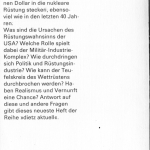
Back Cover Book Description of DDR book “Tödliche Profitgier” (Deadly Profit Greed) about USA weapons industry published in 1986
One of the difficulties with walls is recognizing their existence. The 120 cm thick sheet of concrete curtain cutting through more than 190 streets of Berlin was undeniable. Even from a distance orbiting the earth, the 4.5 – 9 meter thick walls of the Great Wall are visible.
And yet, perhaps the greatest walls are those not so visible.
On November 9, 1989, the Berlin Wall fell and I and my peers sat stunned, knowing we were witnessing a historic event marking the dawn of a new era.
A few years later I was studying International Relations at the University of Vienna with a very small, very international group of students. There was John who had just retired from the US State Department and Maria who had received a special study scholarship from Latvia. Part of our studies included an invitation from the Russian Parliament to visit Moscow for two weeks in June.
Perestroika was on everyone lips and the fact that I, as an American, would be permitted to bypass the sturdy babushka clad lady seated on the women’s hall of the University of Moscow dorms to get to my room — quarters outside of a government approved residence — would have been unthinkable a few years before. That trip I not only got reprimanded by a Kalashnikov wielding guard on the Red Square for smiling and whispering as we circled around the very embalmed Lenin, I also stood in line to get my pass at the salad bar at the Moscow Pizza Hut (Vienna at the time had no Pizza Hut but Moscow did). And I swear to you it’s true when I tell you that when the sun came out that cold June and I walked through Gorki Park, speakers attached to the trees playing rock music began blasting none other than the Scorpions “Winds of Change” over and over again.
Take me to the magic of the moment
On a glory night
Where the children of tomorrow share their dreams
With you and me – Scorpions, “Wind of Change” 
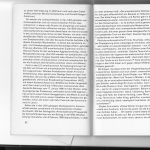
Excerpt about US film industry and anti-Soviet rhetoric (“propaganda”) with examples of films like “Rocky IV”, “Rambo” and “Red Dawn” from DDR book on USA entitled “Deadly Profit Greed”
Original German quote of translation given above from last pages of book, “Countries of the Earth: USA” Ob sich in die Politik eine Linie durchsetzen kann, die das große ökonomische, wissenschaftlich-technische und geistige Potential der USA in die friedliche Zusammenarbeit im Rahmen der internationalen Gemeinschaft zur Lösung der globalen Menschheitsprobleme — allen voran die Friedenserhaltung — einbringt, wird deshalb wesentlich über die Perspektiven der USA-Gesellschaft entschieden. (Seite 160, Stock, Walter: Länder der Erde: USA)
Whose idea was the Berlin Wall? According to the German news magazine, der Spiegel, all Khrushchev’s. Read the English translation of Klaus Wiegrefe’s Spiegel article here: “The Krushchev Connection: Who Ordered the Construction of the Berlin Wall?“
However, an article entitled, “East Germans Pressured Soviets to Build Berlin Wall” by Jodi Koehn on the Wilsons Center website purports that the East Germans pressured Soviets to build the wall

